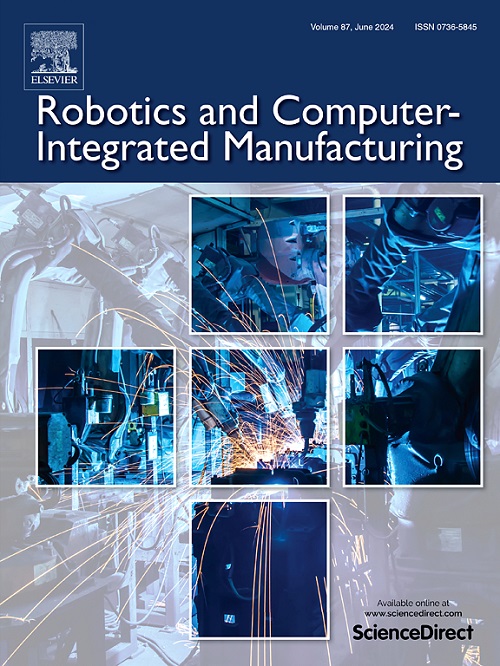Simultaneous high transparency and robust stability-oriented Physical Human-Robot Interaction using an Interaction Intention Filter and a vibration observer
IF 11.4
1区 计算机科学
Q1 COMPUTER SCIENCE, INTERDISCIPLINARY APPLICATIONS
引用次数: 0
Abstract
Physical Human-Robot Interaction (pHRI) systems equipped with compliant admittance controllers typically utilize F/T sensors to capture the forces applied by the operator. However, the impedance force feedback generated by the robot’s motion and the impedance of the human hand can significantly distort the intentional forces. This distortion can lead to vibrations that compromise both interaction transparency and stability. To address this issue, we propose a variable admittance control strategy that incorporates an Interaction Intention Filter (IIF) and an Enhanced Time-Domain Vibration Observer (ETDVO). We first introduce the concept of the IIF, which is designed based on a frequency-domain analysis of force signals collected from real-world human–robot cooperation tasks. This filter effectively prevents unintended impedance force feedback from being transmitted to the admittance controller. Moreover, to ensure interaction stability across diverse environments, we propose a variable-width time window-based ETDVO for accurately computing the vibration index. By leveraging this index, we introduce a variable admittance control strategy based on exponential mapping, which enables rapid adjustment of the admittance parameters, effectively suppresses vibrations and enhances stability. Finally, the proposed strategy is validated through human–robot cooperative laser tracking experiments conducted on a 7-DoF manipulator. Statistical results from the experiments demonstrate that our approach not only improves interaction transparency but also significantly enhances overall stability. Compared to the stable high-gain admittance controller, the Task Time, Required Energy, and Mean Force are reduced by over 10%, 54%, 58%, respectively.
基于交互意图滤波器和振动观测器的高透明鲁棒稳定的人机交互
配备符合导纳控制器的物理人机交互(pHRI)系统通常使用F/T传感器来捕获操作员施加的力。然而,机器人运动产生的阻抗力反馈和人手的阻抗会显著地扭曲意向性力。这种扭曲会导致振动,损害相互作用的透明度和稳定性。为了解决这个问题,我们提出了一种可变导纳控制策略,该策略结合了交互意图滤波器(IIF)和增强时域振动观测器(ETDVO)。我们首先介绍了IIF的概念,它是基于从现实世界的人机合作任务中收集的力信号的频域分析而设计的。该滤波器有效地防止意外的阻抗力反馈被传输到导纳控制器。此外,为了确保在不同环境下的相互作用稳定性,我们提出了一种基于变宽时窗的ETDVO来精确计算振动指数。利用这一指标,我们引入了一种基于指数映射的可变导纳控制策略,该策略可以快速调整导纳参数,有效地抑制振动并提高稳定性。最后,在一个7自由度机械臂上进行了人机协同激光跟踪实验,验证了所提策略的有效性。实验统计结果表明,我们的方法不仅提高了交互透明度,而且显著提高了整体稳定性。与稳定的高增益导纳控制器相比,任务时间、所需能量和平均力分别降低了10%、54%和58%以上。
本文章由计算机程序翻译,如有差异,请以英文原文为准。
求助全文
约1分钟内获得全文
求助全文
来源期刊
CiteScore
24.10
自引率
13.50%
发文量
160
审稿时长
50 days
期刊介绍:
The journal, Robotics and Computer-Integrated Manufacturing, focuses on sharing research applications that contribute to the development of new or enhanced robotics, manufacturing technologies, and innovative manufacturing strategies that are relevant to industry. Papers that combine theory and experimental validation are preferred, while review papers on current robotics and manufacturing issues are also considered. However, papers on traditional machining processes, modeling and simulation, supply chain management, and resource optimization are generally not within the scope of the journal, as there are more appropriate journals for these topics. Similarly, papers that are overly theoretical or mathematical will be directed to other suitable journals. The journal welcomes original papers in areas such as industrial robotics, human-robot collaboration in manufacturing, cloud-based manufacturing, cyber-physical production systems, big data analytics in manufacturing, smart mechatronics, machine learning, adaptive and sustainable manufacturing, and other fields involving unique manufacturing technologies.

 求助内容:
求助内容: 应助结果提醒方式:
应助结果提醒方式:


